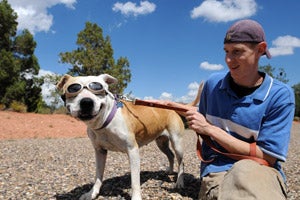Muzzle training for scared and reactive dogs

Have you ever seen a dog outfitted with a muzzle? Frightening, right? It’s time to rethink that notion.
Benefits of muzzle training
Muzzle training can be a useful tool in helping insecure, scared and reactive dogs overcome their issues. Dog caregiver Tazmarie Christensen says, "Muzzle training is an invaluable skill for dogs to learn. It allows dogs to safely meet people and dogs."
Just ask Sookie the dog about her progress since she’s learned to be comfortable wearing a muzzle.
Insecure dog gets help

Sookie prefers treats to eye meds.
When Sookie arrived at the Sanctuary in 2011, she started a treatment regimen for a problem with her eyes. Her eyes do not produce enough tears, which can, in turn, lead to irritation and infections. Caregivers clean and put medication in her eyes several times a day. She also has check-ups with a vet every few weeks.
Dog caregiver Paul Lindey explains the difficulty this treatment presented: "She was insecure about handling and resisted her eye meds. Oftentimes it took two people to administer her eye meds."
Sookie had some trouble with other dogs as well. "(She can be) reactive to other dogs, especially at high excitement times like walks, feeding or when dogs run up and down the fence line," says Paul.
Not to worry, though, Best Friends caregivers and trainers have a few tricks (effective ones at that!) up their sleeves.
Color-coded dog collars
Sookie’s behavior modification plan entailed temporarily making her a red collar dog.

Sookie has made significant progress.
At the Sanctuary, staff use a color-coded collar system to identify who can safely interact with a given dog. This system is for the benefit of the dogs as well as the people who interact with them. (We don’t want to set any of the dogs up for failure.) A variety of factors go into determining which color of collar a dog will wear. Green-collar dogs can be handled by anyone, purple-collar dogs can be handled by people who are 18 years of age and older, and red-collar dogs can only be handled by staff members.
In addition to receiving training assistance with behavior, socialization and other skills, red-collar dogs may also learn to wear a muzzle depending on what the individual dog’s needs are. Taz explains, "(Sookie) started learning to wear a muzzle and was then allowed to visit new people and hang out in the Dogtown lobby. Wearing a muzzle allowed her to safely interact with staff outside of her core caregivers, and allowed us to practice her handling."
Trainers worked with Sookie for a little over year, and in that time, she made significant progress. She has increased her repertoire of good manners. She can now accept petting and handling and can have supervised playdates with other dogs.
Dog makes great progress in overcoming fear and insecurities
Thanks to the patient and careful help of Best Friends caregivers and trainers, not only has Sookie made great progress in overcoming her fears and insecurities, she now has a brand-new purple collar to show for her efforts. This collar-color change allows adult volunteers to work with her, which expand her socialization opportunities.
Next time you see a muzzled dog, instead of tightening your jaw, remember Sookie and how training with a muzzle helped this sweet girl become the best dog she can be.
Video of Sookie with her buddy Rango
Photos by Molly Wald